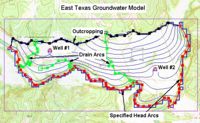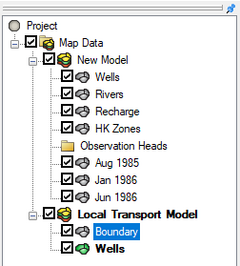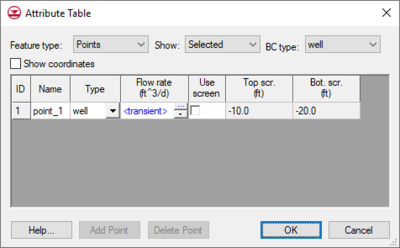GMS:Coverages: Difference between revisions
From XMS Wiki
Jump to navigationJump to search
No edit summary |
|||
| (One intermediate revision by the same user not shown) | |||
| Line 29: | Line 29: | ||
=== Feature Object Properties Categories === | === Feature Object Properties Categories === | ||
{|class="mw-collapsible mw-collapsed" style="width: | {|class="mw-collapsible mw-collapsed" style="width:50%; border:1px solid #D0E0FF; margin-bottom:0.4em;" | ||
|- | |- | ||
!style="text-align:left;"| Sources/Sinks/BCs | !style="text-align:left;"| Sources/Sinks/BCs | ||
| Line 56: | Line 56: | ||
*''Trans. Observed Flow'' – designates transient flow observations which represent gains or losses between aquifers and streams or reservoirs. | *''Trans. Observed Flow'' – designates transient flow observations which represent gains or losses between aquifers and streams or reservoirs. | ||
|} | |} | ||
{|class="mw-collapsible mw-collapsed" style="width: | {|class="mw-collapsible mw-collapsed" style="width:50%; border:1px solid #D0E0FF; margin-bottom:0.4em;" | ||
|- | |- | ||
!style="text-align:left;"|Areal Properties | !style="text-align:left;"|Areal Properties | ||
| Line 66: | Line 66: | ||
*''Horizontal K'' – horizontal conductivity | *''Horizontal K'' – horizontal conductivity | ||
*''Vertical K'' – vertical conductivity | *''Vertical K'' – vertical conductivity | ||
*''Horizontal anis.'' – horizontal anisotropy | *''Horizontal anis.'' – horizontal anisotropy, the relationship between the hydraulic conductivity along columns and the hydraulic conductivity along rows. | ||
*''Vertical anis.'' – vertical anisotropy | *''Vertical anis.'' – vertical anisotropy, the ratio of horizontal to vertical hydraulic conductivity. | ||
*''Specific storage'' | *''Specific storage'' – the amount of water that a portion of an aquifer releases from storage, per unit mass or volume of aquifer, per unit change in hydraulic head. | ||
*''Specific yield'' | *''Specific yield'' – also known as the drainable porosity, is a ratio, less than or equal to the effective porosity, indicating the volumetric fraction of the bulk aquifer volume that a given aquifer will yield when all the water is allowed to drain out of it under the forces of gravity. | ||
*''Top elev.'' – grid top elevation | *''Top elev.'' – grid top elevation of the first layer. | ||
*''Bottom elev.'' – grid bottom elevation | *''Bottom elev.'' – grid bottom elevation of each layer. | ||
*''Wet/dry flags'' – indicate which neighboring cells can cause a cell to become wet or dry. | *''Wet/dry flags'' – indicate which neighboring cells can cause a cell to become wet or dry. | ||
*''Max ET rate'' – maximum rate of evapotranspiration. | *''Max ET rate'' – the maximum rate of evapotranspiration when depth is zero. | ||
*''ET elev.'' – evapotranspiration | *''ET elev.'' – the elevation where the rate of evapotranspiration is at its maximum. | ||
*''ET Extinction depth'' – the evapotranspiration depth | *''ET Extinction depth'' – the evapotranspiration depth below the evaporation surface where the evaporation rate is zero. | ||
*''Porosity'' – assign a porosity value to a polygon. | *''Porosity'' – assign a porosity value to the material on a polygon. | ||
*''MODPATH zone code'' – MODPATH zone codes are assigned using the IBOUND array in the MODFLOW interface. | *''MODPATH zone code'' – MODPATH zone codes are assigned using the IBOUND array in the MODFLOW interface. | ||
*[[GMS:Zone_Budget|''Zone budget ID'']] – zone budget ID is an integer value that can be associated with polygons in a MODFLOW conceptual model in the map module. | *[[GMS:Zone_Budget|''Zone budget ID'']] – zone budget ID is an integer value that can be associated with polygons in a MODFLOW conceptual model in the map module. | ||
| Line 84: | Line 84: | ||
*''Datasets'' – use the Coverage Setup dialog to create a space for a named dataset in the Attribute Table dialog where the values can be added via an XY Series Editor. | *''Datasets'' – use the Coverage Setup dialog to create a space for a named dataset in the Attribute Table dialog where the values can be added via an XY Series Editor. | ||
|} | |} | ||
{|class="mw-collapsible mw-collapsed" style="width: | {|class="mw-collapsible mw-collapsed" style="width:50%; border:1px solid #D0E0FF; margin-bottom:0.4em;" | ||
|- | |- | ||
!style="text-align:left;"|Observation Points | !style="text-align:left;"|Observation Points | ||
| Line 91: | Line 91: | ||
*''Color'' – assign an observation point a color in the Attribute Table dialog. | *''Color'' – assign an observation point a color in the Attribute Table dialog. | ||
*''Cluster Name'' – select a number of observation points and assign them to a group, or cluster by giving the cluster a name. | *''Cluster Name'' – select a number of observation points and assign them to a group, or cluster by giving the cluster a name. | ||
*''Head'' – specify head for observations. | *''Head'' – specify head value for observations. | ||
*''Trans. Head'' – specify transient head values for observation. | *''Trans. Head'' – specify transient head values for observation. | ||
|} | |} | ||



